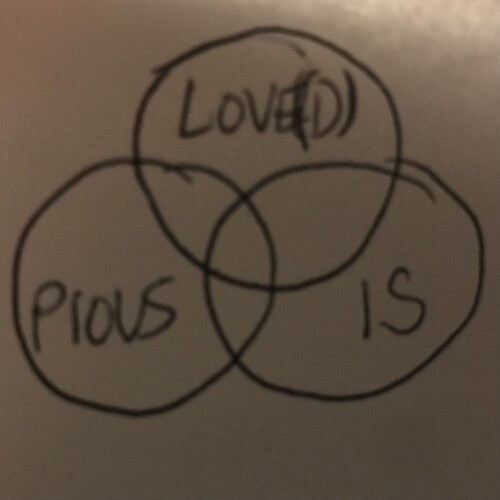This is where I am at–work in progress:
LITMUS KEY: [define the three imports]
J (justified): OUGHT/ACT/DO: Ethico-existential (epistemic) import; Aristotle’s efficient cause.
T (true): IS/FACT/BE: Ontologico-material (scientific/metaphysical) import; Aristotle’s material cause.
B (belief): VALUE/-ATE/END: Hypo-/hyper-thetico-essential (aesthetic/teleological) import; Aristotle’s formal and final cause.
J, T, and B are a reality litmus called a harmonic triad, which means:
-
Analytic: None of them have import unless they each have import independently (as they are distinct from each other) - one cannot stand in for the other.
-
Synthetic: If one of them has import, they all have, had, and/or will have import in alignment with each other (as they all share the same substrate).
THREE FORMS OF DIALECTIC
The first is structured so that when you cross out two conflicting ideas and keep their commonalities, there is something “whole” left standing. This kind of dialectic removes the dross (nihil).
The second is structured so that a privation (nihil) is resolved with something “new” (not nihil) towards a “whole”. This kind of dialectic repairs what is broken.
The third is the starting/ending point (harmonic triad) whole towards which the first two forms of dialectic progress. It is a litmus against which all that is in conflict is compared to distinguish between dross, privation, and wholeness.
(Moral) Truth Litmus
This three-part (Moral) Truth Litmus tells us when a particular (moral/ethical) theory or model is artificial (versus anchored in or descriptive of reality), when that theory or model fails any part of the litmus:
(L1) Part 1: Essential Question Aspect: A (moral) theory/model must describe the answer to a question (“How and why should we be or behave with the other and self?”).
(L2) Part 2: Existential Demonstration Aspect: A (moral) theory/model must be discovered in reality, not created in divergence from reality.
(L3) Part 3: Universal Aspect: A (moral) theory/model must hold for all or none.
If no theory passes all three parts of the litmus, there is no (moral) truth.
Being discovered in/by every culture in history is good for part 3, but to pass part 2, you need a being whose essence is demonstrated (exists its essence).
Three (6?) Distinctions (D)
…Could you say each distinction is attended by two fallacies and two principles (itself, and its reverse)…does reversing the principle have a similar consequence like reversing the fallacy (below)…a way of regressing/returning back to the mean/dao/litmus (baseline is fubar if not the mean/litmus (dao/reality)?
D1. fact (is)-value distinction (violated by F2, F3)
T is distinct from B (and vice versa)
D2. ought-is (fact) distinction (violated by F4, F5)
J is distinct from T (and vice versa)
D3. ought-value distinction (violated by F1, F6)
J is distinct from B (and vice versa)
Six Fallacies (F)
F1. value→ought fallacy (violates D3)
The B→J fallacy (reversal of F6) is when you let value/-ate/end count for ought/act/do.
F2. value→is (fact) fallacy (violates D1)
The B→T fallacy (reversal of F3) is when you let value/-ate/end count for is/fact/be.
F3. is (fact)→value fallacy (violates D1)
The T→B fallacy (reversal of F2) is when you let is/fact/be count for value/-ate/end.
F4. is (fact)→ought fallacy (violates D2)
The T→J fallacy (reversal of F5) is when you let is/fact/be count for ought/act/do.
F5. ought→is (fact) fallacy (violates D2)
The J→T fallacy (reversal of F4) is when you let ought/act/do count for is/fact/be.
F6. ought→value fallacy (violates D3)
The J→B fallacy (reversal of F1) is when you let ought/act/do count for value/-ate/end.
The names of the fallacies have other names than the names given. I have withheld their given names because they often trigger a conflation of some combination of ought/is/value (or justified/true/belief)–and the whole point of this project is to untangle the conflation.
This has application across every field once I get it squared away, but because I don’t have knowledge in every field, I’m not going to be able to fully explain that.

